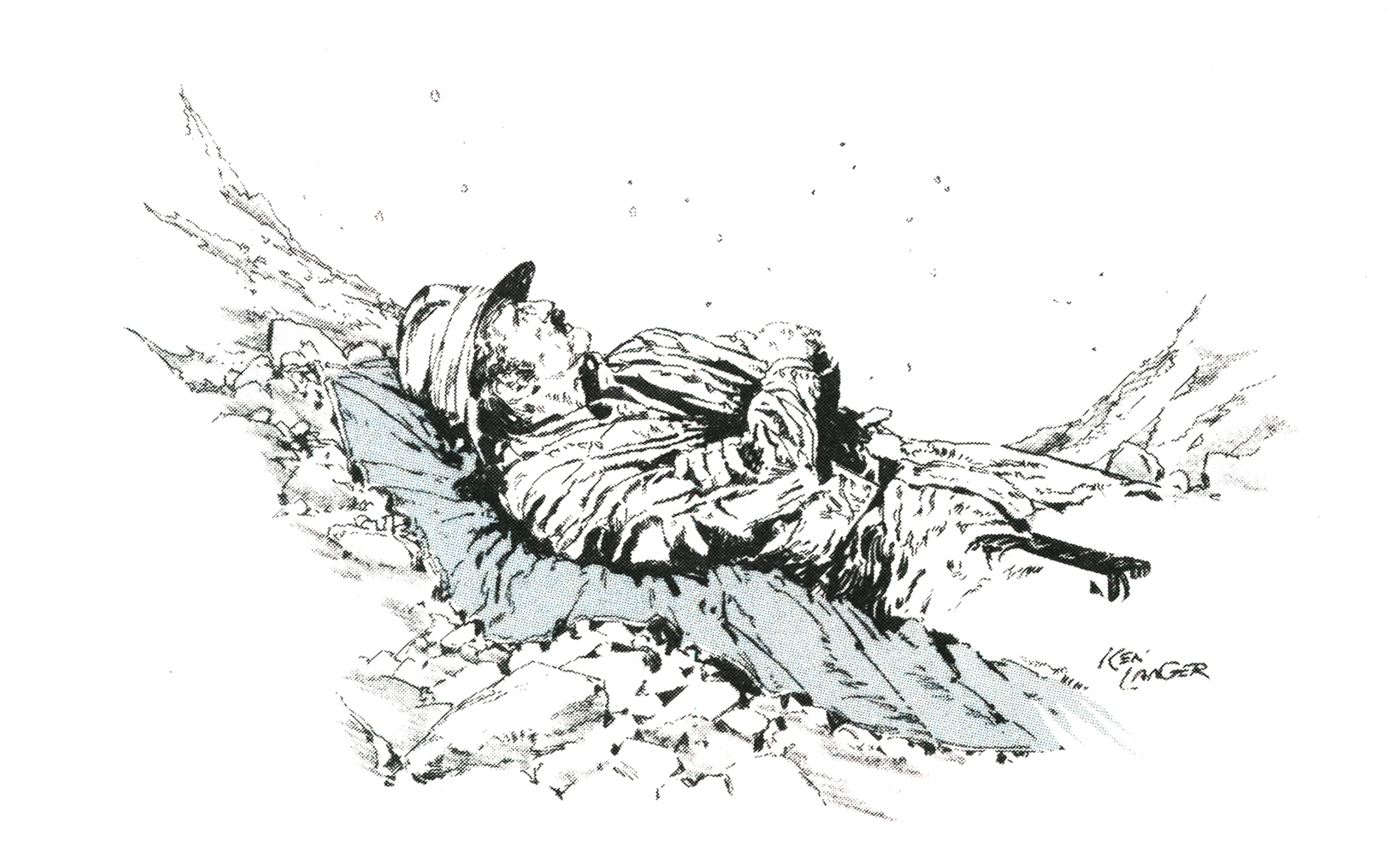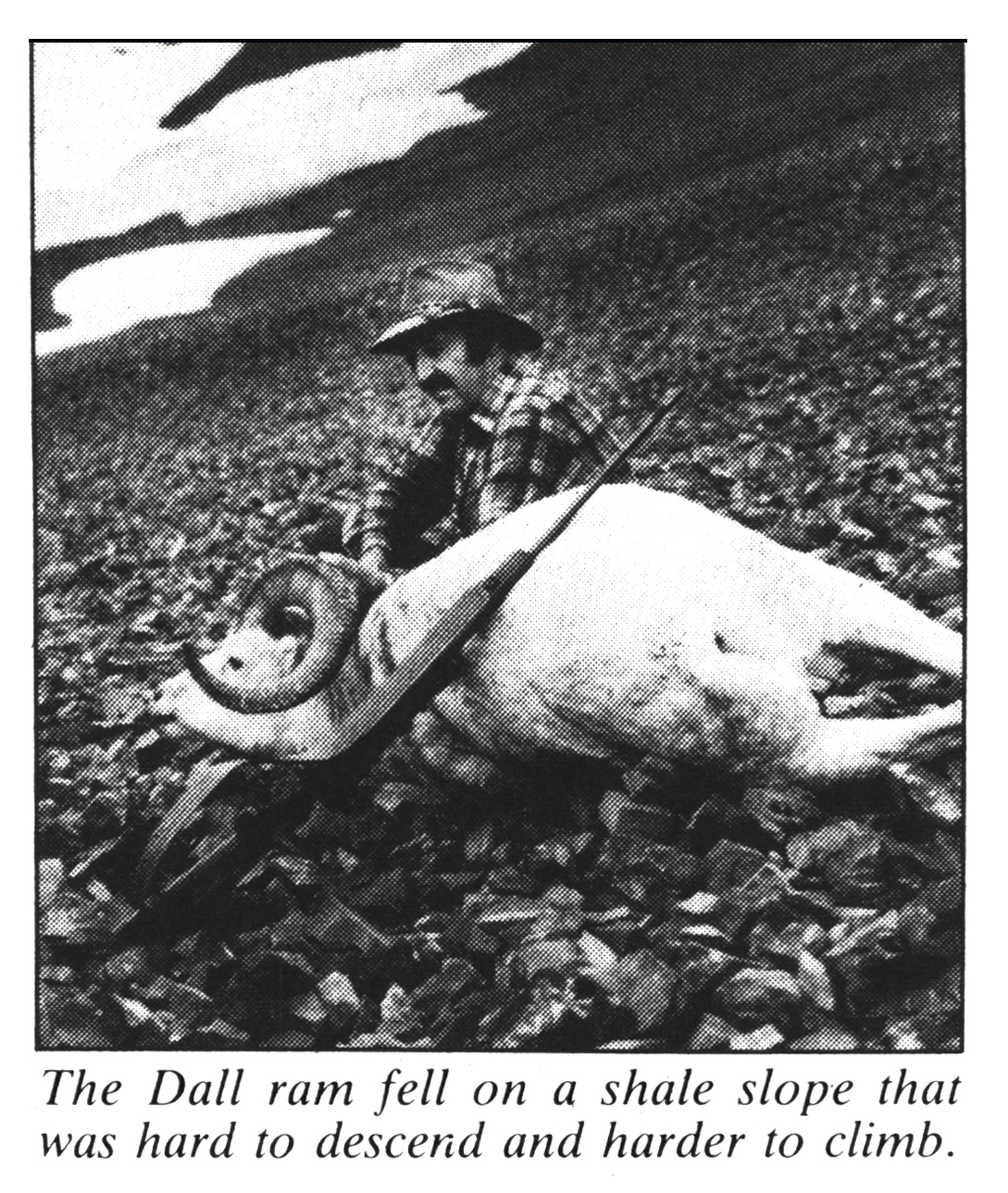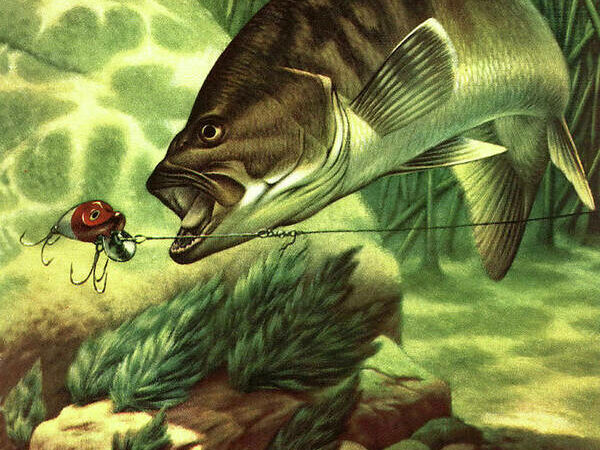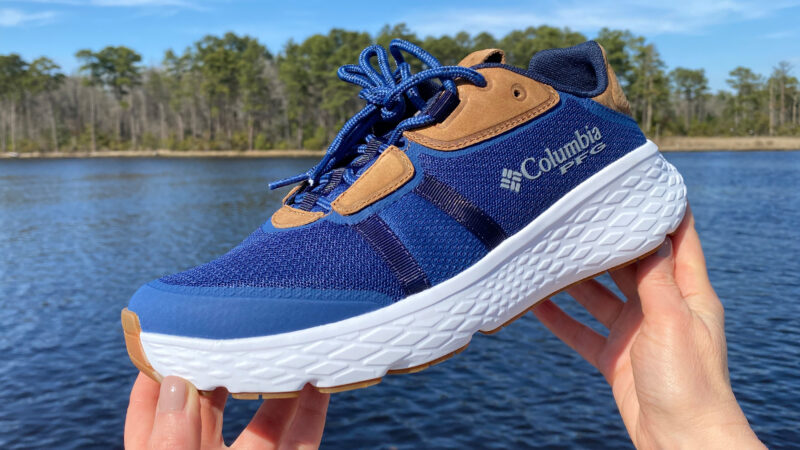Carmichel in Alaska: An Odd Way to Die on a Sheep Hunt
“Is this how it feels to die?” I asked myself, opening my eyes for a moment to watch crystal bits of heaven do a ballet in the Alaskan night. “I can’t be dying because this whole situation is too ridiculous.” I couldn’t help laughing out loud at the idea. I couldn’t believe that I’d meet my end stretched out on the crest of a no-name mountain, dead from a combination of twisted guts and Alaskan-style hypothermia. “Hell, why can’t I go like a respectable sheep hunter-fall off a 6,000-foot ledge or get wiped out by a rock slide. That’s the right way to go. This is ridiculous.” Then I laughed again, out loud. I guess I laughed a lot that night.
I didn’t want to think that I was really going to die, but it was all too plain that I could die. Strangely, the possibility of my imminent demise wasn’t especially bothersome. The sensation could even be called tranquil. I guess that’s how the brain soothes and protects itself when it knows that the body is in one hell of a lot of trouble.
Sensible folks don’t get themselves in such predicaments because they intend to but, rather, because they fall victim to a series of events. The whole thing started a few years previously when I went sheep hunting with my pal Arlen Chaney, president of Omark Industry’s Sporting Division. He wanted a good sheep hunt, of course. but he also wanted to test Omark’s new Grand Slam bullets. Maybe, he suggested, we could start on a grand slam of all four species of North American sheep by taking a beautiful white Dall ram apiece.
On that hunt, we booked with Keith Johnson, an outfitter/guide who has a prime hunting area in Alaska’s Wrangell Mountains and also has a reputation for guiding his hunters to big rams. Arlen got his ram. but I did not. We spotted sheep from camp and Arlen got one of them after a hard climb.

Butch Houteanen, one of Keith’s guides. told me that he knew where a really fine ram was and tried to guide me to him. After an extremely tough climb toward the ram’s favorite high meadow, a light plane began circling and buzzing the ram’s home ground for reasons we never found out. Maybe the pilot was trying to haze the sheep into another another hunting area or, perhaps, he was an anti-hunting fanatic out to deliberately ruin our hunt. The anti-hunters had tried that before the season opened, but all they accomplished was to terrify several magnificent of places, but there were no rams. There were no sheep at all.
During the day, my feet had become increasingly sore. My boots were well broken in and had never caused any trouble but, when we made it back to camp, I discovered that I was in trouble. When I peeled off my socks, they came away crusted with blood and strips of skin. Two days before, my prospects for a great hunt couldn’t have been better; thanks to an imbecile in an airplane and two tender feet, my hunt had ended.
Nearly two years later, I met Keith Johnson and Butch Houteanen at a convention rams, as well as ewes and lambs, until they made suicidal leaps off high cliffs. Whatever the purpose, it was an evil one, but there was nothing we could do about it. The next day, we hiked to the high meadow and then climbed the mountain that lay beyond and looked into hundreds of sheep hunters, and my hunt was suddenly on again. The country had been beautiful, and I knew that I had to go there again to hunt Butch’s great ram.
Come August, I was struggling up another mountain with Butch. The vegetation was even denser and more savage than it had been on the mountain that we’d fought two years before. And this time, the going was made even worse by a steady rain that seeped through our parkas and soaked our clothes, our gear, and our souls. Of particular worry was my much-used .280 bolt rifle, built on a Model 70 action by ace stockmaker Clayton Nelson. I had brought the rifle on one more hunt, determined to retire it in a blaze of glory.
The last of the trail led us to a sheep hunter’s dreamland. All day, the ridgeline had angled slightly upward so that now we had a view that cannot be described or understood — by anyone who has not looked down on the world from a high and wild place.
Much of the stock’s original finish was worn away, leaving patches of unprotected French walnut that were soaking up water like a thirsty blotter. By the time we pitched our tent and downed a freeze-dried supper, my tired old rifle was showing the effects of a rainy day. The forend had swollen so that the barrel was squeezed partially out of its channel. This upward pressure would surely cause the point of impact to be higher than normal, but how much? A foot? Five feet? Was this hunt to end in disaster, too, only because I wanted to take a favorite old rifle on one last hunt?
The dawn came clear and cool, a great day to hunt wild sheep. The savage brush was below us now. Above was only stone and grassy earth, my favorite climbing terrain. Anticipating that the day would soon be too warm for a down jacket and that the climbing would keep me warm anyway, I wore a flannel shirt and a hunterorange down vest instead of a heavy parka. In my daypack were my usual cameras and film, some candy, a plastic tube used to suck water out of snow puddles, and a little packet of some stuff for runners and hikers that is supposed to supply a jolt of energy. Butch didn’t carry much, either. His oversize cargo pack was almost empty, except for a snack, an emergency pack, his spotting scope, and two sets of white “sheep’s clothing.”
By midday, we were above the grass line and had topped out on the nose of a black shale ridgeline. The ridge went more or less straight and level for a couple of miles and crested so sharply that it was impossible to walk on the very top. Doing so would have been like attempting a balancing act on a slippery two-by-four. It was a lot easier and safer to walk a foot or two below the crest, following a faint trail made by years of sheep traffic. The sides of the ridge sloped away sharply but then disappeared completely, meaning that they were edged in vertical cliffs. Even so, there wasn’t much danger. If one of us fell, there were plenty of rocks to grab before going over the edge. The scenery was wonderful and I felt great. Two ridges away soared 16,000-foot Mt. Blackburn, the second highest peak in the Wrangell Range.
The sheep trail ended at a steep-sided saddle in the ridge that dropped nearly 1,000 feet. Butch and I crawled the last few yards along the trail so we wouldn’t be skylined at the start of the saddle. Cautiously, Butch looked first and then ducked back and dug for the spotting scope.
“Four rams,” he whispered, “a couple of good ones, on the left side of the saddle.”
Wiggling forward on my belly, I stuck my nose over the brow of the ridge and scanned the shale slide through my binoculars. For such magnificent animals, wild sheep can sometimes look and act remarkably stupid. These rams looked for all the world like a half dozen of good ol’ boys hanging around a pool hall waiting for something to happen. All were mature, shootable rams and two sported full-curl horns almost wide enough and heavy enough to make a sheep-hunting addict get light-headed and giddy. But “almost” does not a trophy make. Even before Butch had propped his spotting scope on a rock and had focused on the bigger rams, I had decided to give them a pass. The day was still young and there were more days of hunting before us. There might be four more rams, then four more, and even more. The ridgeline continued beyond the saddle and I felt like hiking.
Crossing the saddle, however, presented something of a problem. We wanted to get across without spooking the rams. In a few days’ time, the two with full curls might look mighty good, and we didn’t want to chase them out of the area Our problem was that the right side of the saddle fell away too steeply to cross safely. This meant that we would have to cross on the left side in full sight of the sheep.
Butch’s “sheep’s clothing” provided the answer. We put on the ankle-length white smocks and white caps. Walking single file in a more or less bent-over position, we simply ambled across the saddle in full view of the rams. They stared at us with big-eyed curiosity but didn’t spook. Butch said that he has used his sheep’s clothing to stroll almost within touching distance of wild sheep without alarming them.
The ridge beyond the saddle broadened out into a grassy bench with a shallow, meadowlike saddle just beyond. There we found three more sheep-a young sickleheaded ram and two mature rams with full-curl horns. The largest of the three was about equal in horn length to those that we’d seen earlier, so he was safe for the day. Anyway, the grassy bench was a good place to rest and eat our candy bars while watching the rams through the spotting scope as they went about the peculiar business of being wild sheep.
Though hiking the ridgeline was about as easy as sheep hunting ever gets, crossing the saddles was often murder. The shale was as soft as sand, sucking our feet so deep that every step was a chore. Every mile or so, the ridge collapsed into a saddle, but there were sheep in every saddle. By the third saddle, we had counted 11 rams, including five with full-curl horns. By the time we’d looked at so many rams and sneaked by them in Butch’s sheep suits, the day was getting on. We had only enough daylight to make it back to camp, but the ridge trail ahead was tantalizing and we couldn’t resist looking into one more saddle. After all, the route was easy in spite of the shale and we could find our way back in the dark. The decision to go on was almost my last one.
The last of the trail led us to a sheep hunter’s dreamland. All day, the ridgeline had angled slightly upward so that now we had a view that cannot be described or understood — by anyone who has not looked down on the world from a high and wild place. The crest was becoming so sharp and the sides so steep that soon it would be too dangerous to continue. Even if we saw a good ram, it might be too dangerous to attempt a stalk. Sheep hunters live with danger; it’s part of the game. Just a stroll in sheep country ·might be considered death-defying by flatlanders so, when a sheep hunter says he’s in “bad” country, he’s talking about a place that could kill you. We weren’t in a “bad” place yet, but we were getting close and it was getting dark. That’s when we saw more big rams than I’ve ever seen before in one place.
There were eight big ones, standing proud and wild with their horns curling deep and heavy and then flaring out like wings. One old ram was the one I’d come for. He wasn’t that much bigger than the others, but his horns were deeply engraved by the years. He was a great trophy ram, only a winter or two from natural death in that high place.
I saw more big rams than I’d ever seen before in one place.
The rams weren’t far below us-a bit less than 300 yards. They were standing in a bunch, starkly outlined against the black shale.
“Can we get him out of here if I shoot him?” I asked Butch.
“Don’t worry about that,” he whispered back. “You get him down and then we’ll figure a way to get him out.”
Under normal circumstances, the shot would have been an easy one. My rifle was fitted with a two-legged Harris rest that makes shooting easy, and Butch and I were lying on the off side of the ridge so that I had a solid position. The difficulty was the water that my rifle had absorbed the previous day. The barrel was still partially squeezed out of the channel. Surely that would cause the bullets to hit high, but how much? All I could do was shoot and find out. To allow for the anticipated elevation, plus the extra elevation in bullet impact caused by shooting downhill, I held the Leupold scope’s crosswires just at the chestline. It was a gamble, but the bullet could hit nearly two feet high and still be in the right place.
Butch knew my problem and was watching hard to spot the bullet’s impact in case I missed. All I could do was press the trigger and hope.
“Missed!” he said. “About two feet high.”
Not sure of the danger’s direction, the sheep milled about for a moment and then joined in a tight band. At first, I couldn’t see the big ram, but then he stepped into the clear and stopped. This time, I aimed under the ram’s chest with the crosswires level with his hooves. He was dead before he hit the ground; the Grand Slam .280 Remington bullet had performed beautifully.

It took us the better part of an hour to get to the ram because we had to scramble across a jumble of razor-edged pieces of granite that slashed through the double leather of my boots. Clearly, the shortest way was not the easiest way.
After snapping a few pictures in the fading light and then caping and slabbing off the sheep’s haunches and other edible meat, there was very little daylight left. There was no way down the mountain. At best, all we could do was scramble back to the crest of the ridge before darkness came. This didn’t seem to be too much of a problem because, once on top, we could take our time and pick our way back to camp, even in darkness. After all, we had our sheep and could sleep all next day. With me packing my rifle and the sheep’s head and horns rolled up in the cape and Butch lugging his cargo of heavy sheep meat, we followed a long winding sheep trail to the top of the ridge. It was a hard pull with lots of panting and stops for rest, but we made it to the top in time to see the royal purple of an Alaskan twilight. Then stars filled the night, just out of reach.
After the climb, I felt pretty good, except for being hungry enough to eat at least two of the sheep quarters that Butch carried and wished that I’d packed an extra candy bar or two. That’s when I remembered the packet of quick-energy stuff in my pack. Following the instructions on the packet, I poured the powder into a cup of water and let it bubble and fizz for a moment before drinking.
The bubbling solution hit my stomach and then came right back up, bringing everything else with it. The next instant, I was doubled over in agony, desperately trying not to pass out. When Butch, who had been a couple of minutes behind me, caught up, I was flat on my back, unable to stand, fighting to hold onto consciousness. I must have looked pretty bad because he looked plenty worried.
“What is it, Jim? What happened?”
For terrible minutes, I couldn’t speak. Every time I opened my mouth, my insides tried to climb out.
“It’s that damn quick-energy stuff,” I finally gasped. “It’s killing me.” “Can you walk?”
“No, let me lie here for a while.”
Eventually, the agony went away, but I was so weak that I could barely sit up. Walking seemed impossible but I had to try.
“Let’s go,” I said, trying to sound positive, but when I stood, I staggered and fell to my knees. Then I got up again and lurched along the trail, falling and getting up over and over again.
When we came to the first saddle, I knew that it was no use. The steep shale slide might as well have been Mount Everest.
“I can’t make it, Butch. I’ll have to rest here until morning,” I said. “Tell you what. Why don’t you leave your jacket here and go on to camp? I’ll be OK and you can bring some food in the morning. If I can get some food down, I’ll make it out.”
“No way,” Butch answered. “I couldn’t leave you, even if I wanted to. A guide can’t leave a hunter stranded. I’d lose my license.”
“Well, this is a hell of a place to spend the night,” I said. “We’ll both freeze.”
Then my legs gave way and I collapsed on a bed of cold black shale. There was no grass or even bare earth to lie on and the shards of stone dug at my body in 100 places. But worse than the discomfort was the way that the shale sucked away my body’s vital heat. Other than being in cold water or a strong wind, there is no more deadly way to lose body heat than lying on cold rock, but I had no choice. Without the strength to stand or even sit, there was nothing I could do but lie there and feel the last of my life’s energy creep into a nameless mountain.
Digging into the emergency kit, Butch found one of those thin, aluminum-coated sheets that is supposed to reflect heat.
“Here, lie on this,” he said, “and let’s get as close together as we can. If we lie together like spoons, we’ll help each other stay warm.”
For a while, we lay together — front to back — but it was impossible to stay in one position long because the sharp rocks dug in and soon became so painful that one or both of us had to move. Then the trapped heat would vanish and I’d feel colder than ever. For nearly an hour, we lay huddled together but, as my hypothermia bee11me more severe, I began shaking so violently that it was impossible for us to lie close enough together to do any good. Butch was my only source of heat but he couldn’t help me because I literally shook him off like a dog shaking off water. Finally, I turned over on my back, opened my eyes, and gazed into the brilliant Alaskan heaven. With my head resting on my pack, I was strangely at peace and the cold didn’t seem to matter. This was the beginning of a different and more serious phase of hypothermia. The trembling had stopped. It takes energy to tremble and now I couldn’t do even that. Strangely, my hands and feet didn’t feel especially cold, but I felt a kind of cold that I’d never experienced before. It went deep in my vitals, outlining each of my body’s organs with a hard coating of cold. I could feel my heart, my liver, my kidneys, and my lungs as separate parts, and I could feel each organ reacting to the cold. I considered each part with idle curiosity, as though I was only a bystander at my own death. “How much longer will my liver function?” I asked myself, without really caring. “If I die here, will they name this mountain after me?” Not bad-Carmichel’s Mountain- a place where wild sheep live. Better than Carmichel Street or Carmichelville. I couldn’t help laughing at the idea.
“What the hell’s so funny?” Butch asked.
Surely, I seemed mad.
“Nothing much — just thinking.”
Then I laughed again, louder.
“I wish you’d tell me what’s so funny so I can laugh, too,” Butch said.
“Oh, I was thinking about what a hell of a job you’re going to have packing out my carcass.”
“That’s not funny.”
“I’ve got it,” I said, laughing even harder. “Why not wait until I freeze solid and then saw me in half so you can take me out in two loads.”
“Don’t talk like that,” he said, very quietly.
I’d heard that the last stage of hypothermia is getting sleepy. I’d tried to avoid the feeling but now it came. I was too sleepy to resist, nothing mattered anymore. It was so peaceful. The stars came down from the heavens and touched me, dancing all around, incredibly bright.
“Butch,” I said, nearly dreaming, “it’s a hell of a good ram, isn’t it?” and never heard his answer.
Minutes later, or hours, I don’t know which, I was awake — alive! The sky was lighter; the night was nearly over. I tried sitting up and, for a moment, my head reeled but then steadied. I stood and took a deep breath. Alive! I’d made it. The outline of my head was sharply traced on my pack by a thick layer of frost.
Butch was already on his feet, “How do you feel, pardner?” he asked.
“Great! I’m ready for a hike. Let’s go to camp and get some grub. I want a dozen eggs and some sheep meat.”
Read Next: Great Rifles for Mountain Hunting
“How many sheep did we see yesterday?” I asked as we struggled in the sliding shale.
“Nineteen rams.”
I guess that’s all that really matters to a sheep hunter.
This story, “An Odd Way to Die,” first appeared in the May 1985 issue of Outdoor Life.
The post Carmichel in Alaska: An Odd Way to Die on a Sheep Hunt appeared first on Outdoor Life.
Source: https://www.outdoorlife.com/hunting/carmichel-dall-sheep-hunt-survival/





